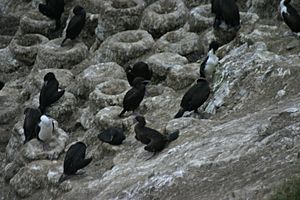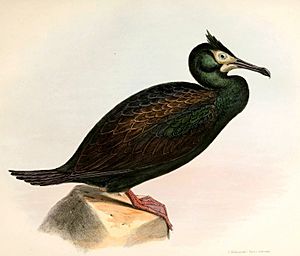Otago shag facts for kids
Quick facts for kids Otago shag |
|
|---|---|
 |
|
| Scientific classification | |
| Genus: |
Leucocarbo
|
| Species: |
chalconotus
|
| Synonyms | |
|
Phalacrocorax chalconotus |
|
The Otago shag (Leucocarbo chalconotus) is a special type of shag bird. It is also sometimes called the bronze shag because of its dark feathers. You can only find this bird living along the coast of Otago, in New Zealand. It is very similar to the Foveaux shag, which lives near Stewart Island.
Contents
What Does the Otago Shag Look Like?
Otago shags are interesting because they can look quite different from each other. This is called being dimorphic. About one-quarter (25%) of these birds have black and white feathers. The rest are completely dark, and these are the ones known as bronze shags. Both types of birds can have babies together.
These birds are quite large and chunky. They grow to be about 70 centimeters (27 inches) long. They usually weigh between 2 and 3 kilograms (4.4 to 6.6 pounds). They are a little bit bigger than their close relatives, the Foveaux shags.
You can tell an Otago shag apart from a Foveaux shag by looking at their faces. Especially during their breeding season, Otago shags have small, bright orange bumps on their faces. These bumps are called caruncles and papillae, and they are found above the base of their beak. Foveaux shags only have the dark orange papillae.
How Otago Shags Are Related to Other Birds
For a long time, the Otago shag and the Foveaux shag were thought to be the same species. They were both called the Stewart Island shag. However, scientists have studied their DNA and bones. They found that Otago shags are actually more closely related to Chatham shags, which live on the Chatham Islands.
Because of these differences, scientists decided in 2016 that the Foveaux shag is a separate species. They think that Otago shags and Foveaux shags became different species a long time ago. This happened when sea levels were much lower, and their groups were separated. Later, shags from Otago likely flew to the Chatham Islands and started new groups there.
Some scientists believe that the Otago, Foveaux, and Chatham shags belong to their own special group of birds called Leucocarbo. Others still place them in a larger group called Phalacrocorax.
Where Do Otago Shags Live and How Are They Protected?
Long ago, Otago shags lived all along the east coast of New Zealand's South Island, up to Marlborough. But when people arrived, their numbers dropped very quickly. The population was reduced by 99% in just 100 years. This also caused them to lose much of their natural variety in their genes.
Now, Otago shags are only found on rocky islands off the Otago Peninsula. Their numbers have not really grown much since then. There are fewer than 2,500 Otago shags left in the world. You can often see them in Otago Harbour, as far north as Oamaru, and as far south as the Catlins.
Because they live in such a small area and have little genetic variety, they need special help to survive. This could include trying to bring them back to parts of their old homes.
Reproduction and Life Cycle
Otago shags build their nests together in large groups, called colonies. They breed from May to September. Their nests are like raised cups, made from plants and their own droppings (called guano) on islands and sea cliffs. These colonies are so big that you can easily see them. The birds use the same nesting spots year after year. A well-known colony is at Taiaroa Head, which is at the entrance to the Otago Harbour.
Otago shags hunt for food in coastal waters that are less than 30 meters (100 feet) deep. You will almost never see them far inland or far out at sea.
Images for kids
See also
 In Spanish: Cormorán de Otago para niños
In Spanish: Cormorán de Otago para niños



